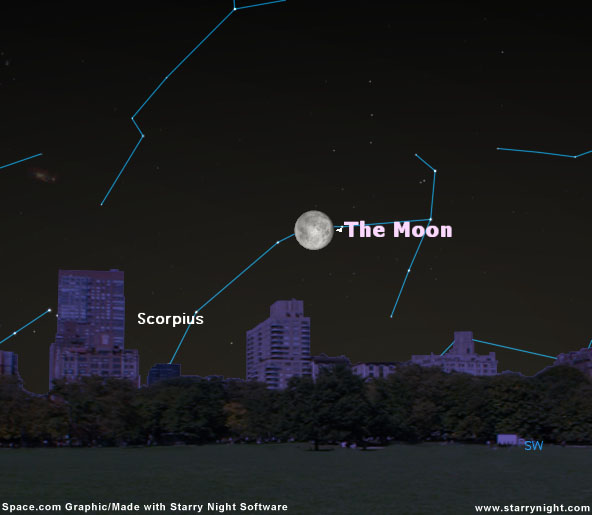Moon to Block a Star May 24

Back on March 3, the Moon crossed in front of the bright red star Antares for much of North America, an event called an occultation. If you missed the event, you'll have another opportunity to see the Moon hide this star early Tuesday, May 24.
First the good news:
As was the case in March, viewers across much of North America are again favored and will be within the visibility zone of this event. Only those living in extreme northern Canada and the Maritime provinces, as well as most of Alaska are out of luck; either the Moon will appear to miss the star completely, or the occultation does not get underway until after the Moon has set. [Timetable]
Now, the bad news:
As was the case back in March, the upcoming occultation will be chiefly an after-midnight affair.
Once again, western observers will be favored. Along the West Coast, Antares will disappear behind the Moon right around midnight and will emerge about an hour later. Best views will be over the southwestern states where Antares will disappear and reappear near the time when it will be at its highest above the southern horizon.
Farther east, the occultation will take place later into the night.
Breaking space news, the latest updates on rocket launches, skywatching events and more!
Easterners will have to make sure their alarm clocks are set for around 4 a.m. Shortly thereafter, Antares will vanish behind the Moon. When the ruddy star is ready to emerge about an hour later, morning twilight will be lighting up the sky for the Middle Atlantic and Northeastern States, with the Moon hanging very low to the southwest horizon. So it is wise to make sure there are no obstructions, like trees or buildings in that direction that might otherwise hide your view of the Moon and reappearing star.
Another challenge
Unlike in March when the Moon was at Last Quarter ('half') phase, this time the Moon is going to be virtually full. In fact, the Moon officially turns full about 12 hours before the occultation. So technically, it will be a waning gibbous Moon that will cover Antares, but 99.7% of its disk will still be illuminated!
So brilliant will be the Moon, that in order to see both the disappearance and reappearance of Antares, you will need to use at least good binoculars, if not a small telescope.
Some hours before the occultation, you'll likely be able to see Antares with your unaided eyes lying just off to the east (left) of the bright Moon. As time passes, the Moon will gradually creep toward the star at roughly its own apparent diameter per hour. Within an hour of Antares vanishing act, the Moon's brilliance may overwhelm the star, making it necessary to use optical aid.
The same will hold true for its reappearance, especially in those areas where dawn twilight has already begun.
Timetable
In the table below, we provide a timetable for 19 selected locations, giving the local times and the Moon's altitude for both Antares' disappearance and reappearance. A single asterisk (*) means the event occurs during morning twilight. From Boston and Montreal, the reappearance of Antares occurs after moonset. For Los Angeles, San Francisco, Seattle and Vancouver, the disappearance occurs on the calendar date of Monday, May 23. The information is based on predictions by the International Occultation Timers Association (IOTA) and has been rounded off to the nearest minute. More detailed information, including maps of the occultation zone, as well as times for more than 275 cities in North America, are available here.
Local circumstances of the occultation of Antares on May 23-24, 2005
| Location | Zone | Disappears | Altitude | Reappears | Altitude |
Atlanta | EDT | 4:11 a.m. | 22? | 5:20 a.m. | 13? |
Austin | CDT | 2:43 a.m. | 32? | 4:02 a.m. | 26? |
Boston | EDT | 4:23 a.m.* | 8? | Not visible | --- |
Chicago | CDT | 3:02 a.m. | 17? | 4:00 a.m. | 12? |
Denver | MDT | 1:27 a.m. | 24? | 2:34 a.m. | 22? |
Great Falls | MDT | 1:17 a.m. | 16? | 2:15 a.m. | 16? |
Kansas City | CDT | 2:50 a.m. | 23? | 3:53 a.m. | 18? |
Los Angeles | PDT | 11:56 p.m. | 27? | 1:16 a.m. | 30? |
Miami | EDT | 4:23 a.m. | 25? | 5:37 a.m.* | 13? |
Montreal | EDT | 4:18 a.m.* | 7? | Not Visible | --- |
New Orleans | CDT | 3:01 a.m. | 29? | 4:17 a.m. | 20? |
New York | EDT | 4:21 a.m.* | 11? | 5:21 a.m.* | 2? |
Phoenix | MST | 12:09 a.m. | 29? | 1:28 a.m. | 30? |
Salt Lake City | MDT | 1:12 a.m. | 22? | 2:21 a.m. | 23? |
San Francisco | PDT | 11:50 p.m. | 22? | 1:06 a.m. | 26? |
Seattle | PDT | 11:57 p.m. | 13? | 1:02 a.m. | 16? |
Vancouver | PDT | 11:57 p.m. | 11? | 1:00 a.m. | 14? |
Washington, D.C. | EDT | 4:19 a.m. | 14? | 5:21 a.m.* | 2? |
Winnipeg | CST | 4:32 a.m. | 11? | 5:13 a.m.* | 6? |
- Full Moon Fever
- Astrophotography 101
- Sky Calendar & Moon Phases
- 10 Steps to Rewarding Stargazing
- Understanding the Ecliptic and the Zodiac
- False Dawn: All about the Zodiacal Light
- Reading Weather in the Sun, Moon and Stars
- How and Why the Night Sky Changes with the Seasons
- Night Sky Main Page: More Skywatching News & Features

Starry Night software brings the universe to your desktop. Map the sky from your location, or just sit back and let the cosmos come to you.
Joe Rao serves as an instructor and guest lecturer at New York's Hayden Planetarium. He writes about astronomy for The New York Times and other publications, and he is also an on-camera meteorologist for News 12 Westchester, New York.

Joe Rao is Space.com's skywatching columnist, as well as a veteran meteorologist and eclipse chaser who also serves as an instructor and guest lecturer at New York's Hayden Planetarium. He writes about astronomy for Natural History magazine, Sky & Telescope and other publications. Joe is an 8-time Emmy-nominated meteorologist who served the Putnam Valley region of New York for over 21 years. You can find him on Twitter and YouTube tracking lunar and solar eclipses, meteor showers and more. To find out Joe's latest project, visit him on Twitter.

